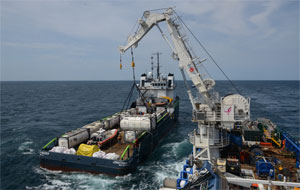In one of the largest operations of its kind ever undertaken in the United States, a salvage contractor working with federal and state agencies has removed 476,000 gallons of oil from a leaking tanker sunk off Long Island by a German U-boat during World War II.
The removal of the oil from the 423-foot Coimbra began in mid-May after it was determined that eight tanks still contained oil and one had a pinhole leak. The project, accomplished with the assistance of a 6,000-pound remotely operated vehicle (ROV), concluded in July.
The undertaking was initiated by the Coast Guard, which established a unified command with the New York State Department of Environmental Conservation (DEC). For four years, the Coast Guard had been receiving satellite observation reports of a sporadic oil sheen on the Atlantic Ocean near the location of the 6,800-ton, British-flagged tanker. It sank in three pieces in 180 feet of water 30 miles off Shinnecock, N.Y., after being struck by two torpedoes fired by U-123 on the morning of Jan. 15, 1942.
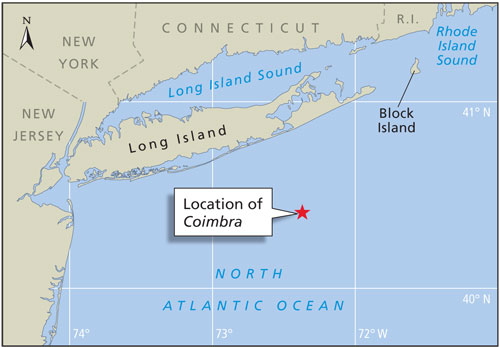 |
|
The British tanker Coimbra was torpedoed by a German U-boat off Long Island in January 1942, killing 36 mariners. |
|
Pat Rossi illustration |
Initial dive operations in May 2019 confirmed the tanker was leaking small amounts of lubricating oil from its initial 64,000-barrel cargo.
“The (more than) 450,000 gallons removed from the Coimbra over the last three months were a hidden threat to the health of Long Island’s marine fishery and the South Shore’s environment,” DEC Commissioner Basil Seggos said. “The Coimbra now complements New York’s growing network of artificial reefs, which serve as an economic driver for the region’s diving and fishing industries.”
“The amount remaining in the vessel is very small and any sheening poses minimal risk to the local environment and no risk to the shoreline,” said Steve Lehmann, senior scientific coordinator at the National Oceanic and Atmospheric Administration. Any further potential environmental impact will be monitored by NOAA.
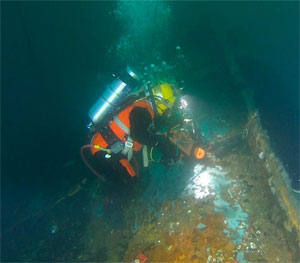 |
|
A diver from Resolve Marine Group drills into the hull of Coimbra in early May. |
|
U.S. Coast Guard |
Eighty-three people, including up to 55 at a time employed by Florida-based Resolve Marine Group, were involved in the operation, according to Collin Reichelt, a spokesman for Coast Guard Sector Long Island Sound. The oil removal was done by the Resolve team, which included divers, a remote vehicle operator, oil sampler, marine biologist, marine archaeologist, naval architect, pump operator and cook. It took 193 dives to complete the mission, Reichelt said.
Aaron Jozsef, deputy director of projects and the on-site coordinator for Resolve, said the hard-hat divers breathed a surface-supplied helium-oxygen mix. They spent 60 to 80 minutes on the bottom, followed by 90 minutes of in-water decompression and 2.5 hours in a recompression chamber on the recovery vessel.
“The ROV does a lot of prep work,” Jozsef said. “It did a lot of the hull cleaning, the thickness testing, and the visual observation and the monitoring for safety and environmental purposes. It also pre-staged equipment for our divers. The divers did the sampling and the probing (and) drilled some of the holes.”
Once on site, the first phase of the operation was assessment, “where we make our map of the entire wreck,” Jozsef said. “That was followed by a metal thickness analysis of the hull. Next, using historical information, we had to figure out where the frames and tank boundaries were. Then we had sampling, where we put a hole in the boat and were able to measure the total volume of oil in (each) tank. Then we prioritized which tanks had the most amount of oil.”
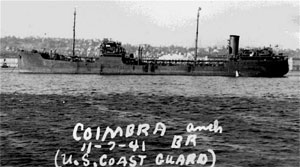 |
|
Coimbra was en route to Britain from New York when it was attacked off Shinnecock, N.Y. |
|
U.S. Coast Guard |
Jozsef said samples from the tanks underwent laboratory analysis to make sure “there were no surprises from a disposal standpoint.”
“In this case, we had two different pumping evolutions,” he explained. “The first was lube oil, which is a lighter product that’s fairly stable. We used a surface-submerged pump directly connected to the hull to pump the oil into our tanks. The second phase was the heavy fuel oil that we found, about 100,000 gallons or so. For that, we actually had to heat it using injected hot water and then used a bigger pump to pump it up into our tanks.”
Jozsef said it could take up to several days to empty one tank, and there were almost two dozen tanks on Coimbra.
“We removed the majority of what we could get,” he said. “You can’t quantify it because we didn’t know how much was there to begin with. You’re never going to get 100 percent of the oil, considering it was blown up with two torpedoes and it’s a mass of metal on the bottom of the ocean (that is) not easy to get to.”
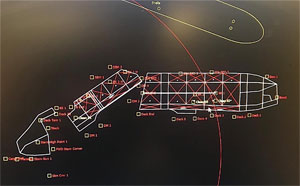 |
|
A diagram of the wreck site shows Coimbra in three pieces on the bottom of the Atlantic Ocean. The tanker’s cargo was stowed in nearly two dozen tanks. |
|
U.S. Coast Guard |
Some of the oil burned off and some of it leaked out after the torpedoes hit, Jozsef said. The ship’s manifest said Coimbra was carrying 2.7 million gallons, and it was estimated that 1.2 million gallons remained for recovery. “We recovered just shy of half of what that estimate was,” he said. The oil was recycled at a state-approved facility in New York.
“As far as I’m aware, this is one of the largest fuel removals ever conducted of a World War II wreck in the United States,” he continued. “And considering that we did it in just under 90 days, it was probably the most efficient as well.”
Almost everything went according to plan, Jozsef said. One exception was that Resolve did not anticipate the volume of heavy fuel oil that was found on board.
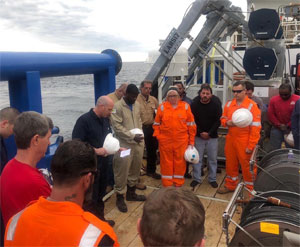 |
|
Responders hold a memorial ceremony for the lost crewmembers of Coimbra during oil recovery operations aboard Shelia Bordelon. |
|
U.S. Coast Guard |
“That was probably the biggest engineering hurdle for us,” he said. “We had to pull into port in Philadelphia and in 10 days put together a heating recirculation and skimming system with an onboard boiler and storage system. That was the biggest technical challenge. We expected and planned for lubricating oil. We thought there was a potential for some heavy fuel oil, but surprisingly two tanks in the stern section and three forward all had fuel oil in them.”
The fuel used for propulsion of the ship was thought to have burned up in the fire after the torpedo strikes.
A 1975 assessment of the wreck estimated the maximum remaining contents of Coimbra’s cargo tanks at 28,500 barrels. NOAA determined that a worst-case spill could have resulted in contamination at beaches from North Carolina to Cape Cod.
Capt. Kevin Reed, commander of Coast Guard Sector Long Island Sound, said the quickly dissipating sheens spotted in the tanker’s vicinity could have amounted to five to 10 gallons each on average. They would evaporate quickly in the wind, waves and sun, according to Matt Franklin, DEC director of emergency management.
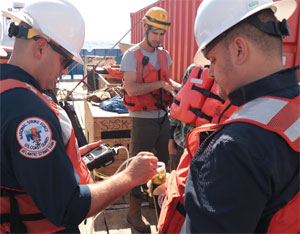 |
|
Joshua Marks of the Coast Guard’s Atlantic Strike Team tests oil recovered from the wreck. Crews removed 476,000 gallons of lubricating oil and heavy fuel oil. |
|
U.S. Coast Guard |
Consultation assistance for the recovery operation was provided by the Navy Supervisor of Salvage and Diving; the Coast Guard’s Atlantic Strike Team, Salvage Engineering Response Team, and Office of Environmental Management; NOAA; and the state DEC.
Coimbra was one of the many merchant vessels lost off the East Coast during what German submarine commanders referred to as the “Second Happy Time,” when Axis subs destroyed more than 600 Allied ships in eight months. On the first day of the recovery project, there was a moment of silence to honor those who lost their lives on the tanker 77 years ago. Only 10 of the 46 crewmembers survived.
The wreck is a favorite destination of offshore fishermen seeking tuna, shark, cod and other species. Well below recreational dive depth, it does attract a small number of technical wreck divers.

